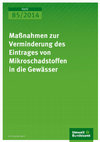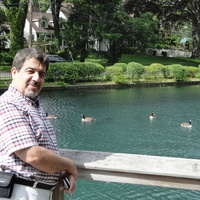Papers by Eve Menger-Krug

Die Reduzierung der Belastungen der Gewässer mit Mikroschadstoffen ist seit vielen Jahren eine wi... more Die Reduzierung der Belastungen der Gewässer mit Mikroschadstoffen ist seit vielen Jahren eine wichtige Zielsetzung der Wasserwirtschaft. Für ausgewählte Mikroschadstoffe, für die das kommunale Abwassersystem der dominierende Eintragspfad ist, werden die emissionsrelevanten Stoffflüsse analysiert und teilweise zusätzlich der Stoffeintrag in die Gewässer modelliert. Die Ergebnisse dienen als Grundlage für die Ableitung von Emissionsminderungsmaßnahmen. Ein Schwerpunkt sind dabei Untersuchungen zu Kosten und zur Wirksamkeit der Einführung einer vierten Reinigungsstufe in kommunalen Kläranlagen und der dabei zu berücksichtigenden Rahmenbedingungen. Gleichzeitig zeigen die Arbeiten, dass auch quellenorientierte sowie dezentrale Maßnahmen je nach betrachtetem Stoff eine kosteneffiziente Möglichkeit zur Emissionsminderung darstellen und einen wesentlichen Beitrag zur Umsetzung des Verursacherprinzips leisten können. Die erzielten Ergebnisse verdeutlichen den Handlungsbedarf hinsichtlich e...
Gas Wasserfach Wasser Abwasser
Today, Germany is moving to more sustainable energy systems. This challenges also the wastewater ... more Today, Germany is moving to more sustainable energy systems. This challenges also the wastewater sector to improve energy balances of infrastructures. Besides energy efficiency, also reuse of resources from wastewater offers large energy potentials. While Germany represents a best practice example for wastewater management within the technical paradigm, there are large opportunities for energetic reuse of wastewater resources, which are not yet fully exploited. The purpose of this paper is to give an overview of material and energy flows in wastewater infrastructures in Germany today, and to present two eco-innovations for improved energy balances. Making full use of synergies between energy and (waste)water infrastructures is an important feature of sustainable cities of tomorrow.
Ceramic Forum International
Clay minerals are ubiquitous in soils and sediments. They are very small particles (<2 µm), with ... more Clay minerals are ubiquitous in soils and sediments. They are very small particles (<2 µm), with a large surface area and layer charge which makes them very important inorganic catalysts in terrestrial ecosystems. Clay minerals effectively adsorb DNA, RNA and Proteins interfering with DNA extraction. The slow turn over rate of DNA in the presence of clay minerals (weeks to years) makes it inherently difficult to trace shifts in community composition by direct DNA extraction.

Clays and Clay Minerals, 2014
ABSTRACT To date, ~1% of all bacteria that occur in environmental ecosystems such as soil, sedime... more ABSTRACT To date, ~1% of all bacteria that occur in environmental ecosystems such as soil, sedimentary rocks, and groundwater have been described. Comprehensive explanation of ecological interactions on a microscale level is thus almost impossible. The Dynamic Cultivation System (DCS) was developed in order to detect more microbial taxa than with common cultivation approaches, as well as previously undescribed bacterial species. The DCS is a quick and easy in situ method for the cultivation of numerous bacterial taxa in support of the description of microbial colonized ecosystems. To investigate the bacterial populations within a clay-maturation process after mining the raw material, the DCS was used to increase the microbial biomass for further molecular analysis. Two different methods were applied to extract the bacteria from the DCS and these were compared in terms of efficiency at detection of large numbers of different taxa and in terms of applicability to the detection of previously undescribed species in raw clays. A collection of different undescribed species was detected with sequencing. While direct picking of bacterial colonies leads to the detection of different genera, species mainly of the genus Arthobacter were proved in the phosphate-buffered saline-suspended biomass. Thus, a combination of the approaches mentioned above is recommended to increase the number of detectable species. The DCS will help to describe better the microbial content of ecosystems, especially soils that contain charged particles.
Der demografische Wandel wird in Deutschland zu einem deutlichen Rückgang der Bevölkerungszahlen ... more Der demografische Wandel wird in Deutschland zu einem deutlichen Rückgang der Bevölkerungszahlen führen. Dabei werden sich die Bevölkerungszahlen sowohl regional als auch lokal sehr unterschiedlich entwickeln. Die großen, bereits seit den 1990er Jahren ...

Environmental Science & Technology, 2012
Integrating microalgae systems (MAS) at municipal wastewater treatment plants (WWTPs) to produce ... more Integrating microalgae systems (MAS) at municipal wastewater treatment plants (WWTPs) to produce of bioenergy offers many potential synergies. Improved energy balances provide a strong incentive for WWTPs to integrate MAS, but it is crucial that WWTPs maintain their barrier function to protect water resources. We perform a prospective analysis of energy and emission balances of a WWTP with integrated MAS, based on a substance flow analysis of the elements carbon (C), nitrogen (N), and phosphorus (P). These elements are the main ingredients of wastewater, and the key nutrients for algae growth. We propose a process design which relies solely on resources from wastewater with no external input of water, fertilizer or CO(2). The whole process chain, from cultivation to production of bioelectricity, takes place at the WWTP. Our results show that MAS can considerably improve energy balances of WWTPs without any external resource input. With optimistic assumptions, they can turn WWTPs into net energy producers. While intensive C recycling in MAS considerably improves the energy balance, we show that it also impacts on effluent quality. We discuss the importance of nonharvested biomass for effluent quality and highlight harvesting efficiency as key factor for energy and emission balances of MAS at WWTP.

Applied Clay Science, 2012
ABSTRACT A major problem in the analysis of natural bacterial populations is that probably less t... more ABSTRACT A major problem in the analysis of natural bacterial populations is that probably less than 1% of species were so far cultured and described. In order to overcome this disadvantage, culture independent DNA based methods, such as comparison of PCR-amplified 16S rRNA genes, are used for the description of the bacterial diversity and the identification of various species. Unfortunately, each molecule of DNA, including those of dead organisms and allochthonous genomes, can be detected by PCR-based molecular fingerprint techniques within a sample besides the DNA of native organisms. Hence, an adequate image of the actually active population composition cannot be projected with these methods. An additional challenge is the extraction of DNA from charged particles and the presence of inhibitors for downstream molecular analyses. This study reports the results of a new cultivation approach that allows to overcome these problems and to obtain almost total environmental DNA of microorganisms for subsequent genetic DNA fingerprint techniques. This new approach, the Dynamic Cultivation System (DCS) is characterized by special nutrient availability to simulate the bacterial natural habitat and the cell–cell interaction for various processes, such as collective degradation of compounds. The DCS was applied in combination with the genetic fingerprint technique Denaturing Gradient Gel Electrophoresis (DGGE) to study changes in the population composition during an alteration process of clay. The results indicate a changing bacterial diversity over time which seems to correlate to the changing pH in the clay samples in situ. This effect was most evident after cultivation on the DCS.

Die Reduzierung der Belastungen der Gewässer mit Mikroschadstoffen ist seit vielen Jahren eine wi... more Die Reduzierung der Belastungen der Gewässer mit Mikroschadstoffen ist seit vielen Jahren eine wichtige Zielsetzung der Wasserwirtschaft. In der Europäischen Wasserrahmenrichtlinie 2000/60/EG zur Schaffung eines Ordnungsrahmens im Bereich der Wasserpolitik ist in Artikel 16 „Strategien gegen die Wasserver-schmutzung“ festgelegt, dass spezifische Maßnahmen zur Bekämpfung der Wasserverschmutzung durch relevante Schadstoffe oder Schadstoffgruppen umzusetzen sind. Über die Richtlinie 2008/105/EG wurden für 33 prioritäre Stoffe bzw. Stoffgruppen Umweltqualitätsnormen (UQN) als Zielgrößen zur Erreichung des guten chemischen Zustandes der Oberflächengewässer festgelegt. Bei Überschreitung dieser UQN sind Maßnahmen zur Verminderung bzw. Vermeidung von Emissionen, Einleitungen und Verlusten dieser Stoffe durch die Mitgliedstaaten zu implementieren. Über die Richtlinie 2013/39/EG zur Änderung der Richtlinien 2000/60/EG und 2008/105/EG wurden die bisherigen UQN teilweise angepasst sowie zwölf ...











Uploads
Papers by Eve Menger-Krug